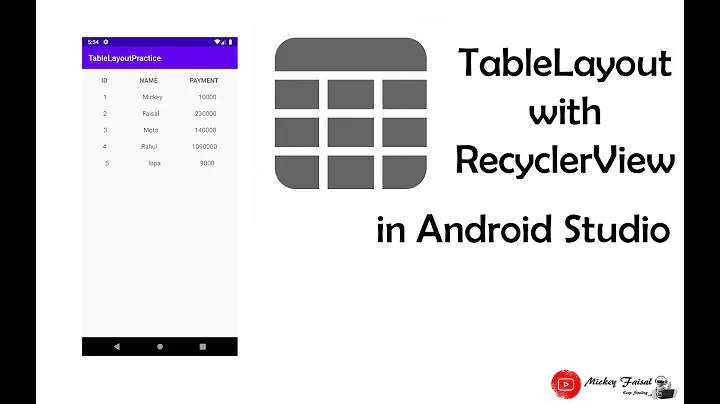Create TableLayout programmatically
58,616
Solution 1
Just to make the answer more clear:
TableLayout.LayoutParams tableParams = new TableLayout.LayoutParams(TableLayout.LayoutParams.WRAP_CONTENT, TableLayout.LayoutParams.WRAP_CONTENT);
TableRow.LayoutParams rowParams = new TableRow.LayoutParams(TableRow.LayoutParams.WRAP_CONTENT, TableRow.LayoutParams.WRAP_CONTENT);
TableLayout tableLayout = new TableLayout(context);
tableLayout.setLayoutParams(new LinearLayout.LayoutParams(LinearLayout.LayoutParams.WRAP_CONTENT, LinearLayout.LayoutParams.WRAP_CONTENT));// assuming the parent view is a LinearLayout
TableRow tableRow = new TableRow(context);
tableRow.setLayoutParams(tableParams);// TableLayout is the parent view
TextView textView = new TextView(context);
textView.setLayoutParams(rowParams);// TableRow is the parent view
tableRow.addView(textView);
Explanation
When you call setLayoutParams, you are supposed to pass the LayoutParams of the parent view
Solution 2
It turns out I needed to specify TableRowLayout, TableLayout etc for the layout params, otherwise the table just won't show!
Solution 3
A good solution is to inflate layout files for each instance of row you want to create. See this post : How to duplicate Views to populate lists and tables?
Related videos on Youtube
Author by
mark
Updated on July 09, 2022Comments
-
mark almost 2 years
I'm trying to create a TableLayout programatically. It just won't work. The same layout in an xml file works though. This is what I have:
public class MyTable extends TableLayout { public MyTable(Context context) { super(context); setLayoutParams(new TableLayout.LayoutParams(LayoutParams.FILL_PARENT, LayoutParams.WRAP_CONTENT)); TableRow row = new TableRow(context); row.setLayoutParams(new TableRow.LayoutParams(LayoutParams.FILL_PARENT, LayoutParams.WRAP_CONTENT)); Button b = new Button(getContext()); b.setText("hello"); b.setLayoutParams(new LayoutParams(TableRow.LayoutParams.FILL_PARENT, TableRow.LayoutParams.WRAP_CONTENT)); row.addView(b); addView(row) } } ... // In main activity: MyTable table = new MyTable(this); mainLayout.addView(table);When I run this, I don't get a crash, but nothing appears. If I get rid of the TableRow instance, at least the button does appear as a direct child of the TableLayout. What am I doing wrong?
-
 Atma over 12 yearsCan you post your code solution? It looks like you are already doing that above.
Atma over 12 yearsCan you post your code solution? It looks like you are already doing that above. -
Brayden almost 12 yearsThank you! @Atma TableRows should use TableLayout.LayoutParams and views inside the TableRows should use TableRow.LayoutParams. :)
-
Geert Weening about 11 yearsHorrible that you need to explicitly do this, but it worked for me, thanks!
-
Anonsage over 9 yearsThank you @Brayden! That was the small detail I missed in my subclass of TableLayout that automatically had all TableLayout.LayoutParams and not TableRow.LayoutParams!
-
Leon over 8 yearsShouldn't it be tableRow.setLayoutParams(rowParams) ?
-
Muneeb Mirza almost 8 yearsThe life saver award goes to @Gigori A. and mark. Gigori A. for this answer and mark for his own answer.
-
 The_Martian over 7 yearsGreat and helpful solution. As a side note, you should add the row to the table before you add the textview to the row. tableLayout.addView(tableRow);
The_Martian over 7 yearsGreat and helpful solution. As a side note, you should add the row to the table before you add the textview to the row. tableLayout.addView(tableRow); -
 Starwave almost 7 yearsSpent an hour trying to figure out what I was doing wrong - turns out in your code you missed adding
Starwave almost 7 yearsSpent an hour trying to figure out what I was doing wrong - turns out in your code you missed addingtableRowto thetableLayout:tableLayout.addView(tableRow);






